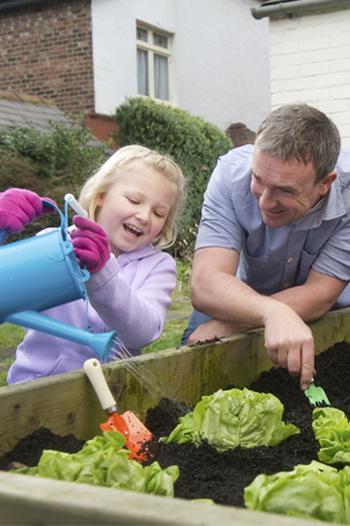Planting a garden you can eat
Duration/age

Planting a small vegetable and herb garden with your child gives them a chance to experience the sensation of soil on their hands. Together you can make choices about what to plant and you will be able to observe the changes as the plants grow and begin to produce fruit, vegetables or herbs.
Before getting started, make a trip to the local supermarket and walk through the fruit and vegetable section together, looking at what is currently in season. Make a list of the different vegetables that you and your child like as this will help you later when you go to the garden centre. Talk together about what you can cook or make with the produce that you will grow.
You will need to identify how much space you have as this will help you to decide how big a container you will use for planting the seedlings. If you have not grown these plants before you may need to find out information about where they will grow. Will they need full sun or a mixture of sun and shade?
When you go to the garden centre, be sure to take a look at the labels on the seedlings. As you read the instructions together explain that the symbols and information help you to know where to plant the seedling, how much water and sun it will need, how big it will grow and how long before it produces food you can eat.
Back at home your child can fill the big container with the potting mix and have a go at creating the holes to tuck the seedlings into. Before planting the seedlings talk about the order to plant them in, such as the big ones at the back and the smaller ones in the front. You can help them to work out the distance between each seedling by using a ruler or a stick to measure the size required between each hole. For younger children you could place a stone where each plant needs to go.
Materials you will need
- Seedlings
- Spade
- Potting mix
- Watering can
- Big container
- Smaller containers
- Plant labels
- List of plants to buy
Alternative tools
- Bucket
- Computer
- Junk mail
- Garden bed
- Packet of seeds
Skills this activity improves
Why does this matter?
By selecting what to grow, finding the seedlings at the garden centre and planting the seedlings, children are learning to describe, compare and sort objects by size, position, time and temperature. As children participate in selecting what to plant they are learning to make decisions and to use written information to help inform them. As they look at the labels they are exploring how information can be presented and that at times it will be written where other times it will be presented as a symbol or a number.
What does this lead to?
As children make choices about what they like to eat and what they will grow they are beginning to use data to make decisions. When selecting the plants they are making decisions based on “likes”, time or space. Exploring the different terms and attributes we use to describe objects such as width, size and heat helps children to understand that we can measure objects in different ways and that the tools we use to measure will be different depending on what we are measuring.
Growing plants to eat also helps children to combine reading, writing, symbols and mathematical reasoning into the planning of the design of the “veggie garden”.
Language to use
- Vegetable, fruit, flower
- Fast growing, slow growing
- Up, down, across
- Roots, stem, leaf, flower, bud
- Time, calendar, days, month, season, weather
- Sun, shade
- Drought tolerant, watering
- Container, potting mix, spade, label
Questions to use
- What will we plant to eat?
- How long will it take to fruit?
- How many plants will fit in the big container?
- Will that grow in sun or shade?
- How often does it need to be watered?
Useful tips
- If you are unable to travel to the supermarket to look at the fruit and vegetables in season you could use catalogues from local supermarkets.
- Google what is in season before deciding what to plant.
- To help your child find the right plants at the garden centre, take photos or cut out pictures from the junk mail.
- Encourage your child to select plants that are fast growing and can be eaten raw such as lettuce, cherry tomatoes, strawberries, capsicum, zucchini and cucumber.
- Remember to talk to your child in your home language.
More ideas
- Make your own labels for the plants.
- Look up recipes to cook with your produce.
- Collect seeds from your produce to plant next year.
- Make a calendar for watering the garden.
- Mark on a calendar when you planted them and mark off each day until you have something to pick and eat.
Variation by age
Three to five year olds
- Make a scarecrow to scare away the birds.
- Find out what companion plants to grow together to stop bugs from eating your produce.
Questions to ask
- What can we plant together?
- What can we eat raw and what will need to be cooked?
- Does everyone in the family like the same foods?
- Which are fruits and which are vegetables?


